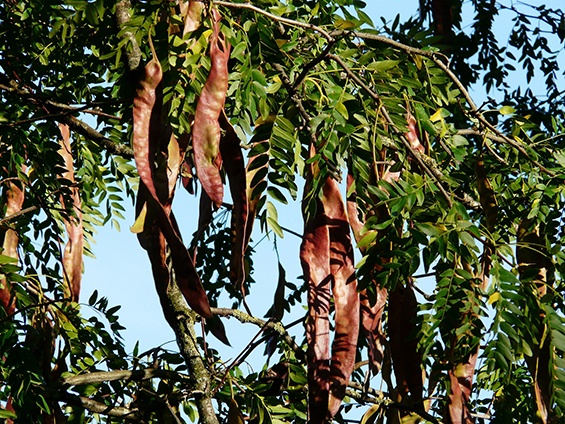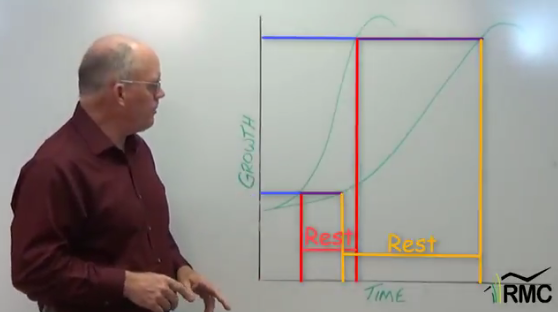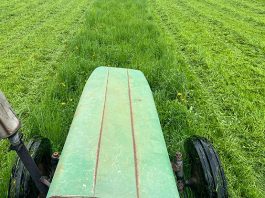Do you know how much forage you have stockpiled for this winter?
What would you do with 2,000 extra pounds of high-energy, self-harvested feed per acre? What about 4,000lbs?
What would that do to your feed bill?
How would that change your bottom line?
Having that much extra winter forage doesn’t have to be something you just dream about. Read on for a winter feed solution that could work for you!
The first snow of the season has fallen in my area, forage growth has all but ground to a halt, and all that’s left to feed is whatever hay and standing forages were stockpiled. While a tremendous amount has been learned about stockpiling forages over the past decades, we may have completely neglected a game-changing source of winter feed: TREES

While cool-season grasses do their best work in the spring, fall is the time when trees really shine. Fall is what trees work towards all year long, converting sunlight into seed for the next generation. Some trees, like elm or maple, are stingy about their seeds, encapsulating them in dry, papery husks. Yet other trees will gladly partner with large herbivores, packaging their seed in large, sweet, high-energy fruits and pods, a perfect treat for anything from deer to Holsteins. That’s true in the case of Honeycrisp apples, and it’s true in the case of honey locust trees.
When I talk honey locust, I’m talking about selected, quality-genetic, thornless, high-yielding, high-energy-pod-producing honey locusts. If you’re only familiar with the thorny wild trees that yield dry, leathery pods, I’m sorry. It’s like someone who understandably hates burgers, because all they’ve ever been served are boiled soy-burgers. Once they taste a bacon-topped, medium-rare, half-pound, grass-finished, flame-broiled beauty, they’re hooked for life.
Good honey locusts might as well have been custom-made to compliment grazing. One would be hard-pressed to come up with a better tree.
Let’s start with shade.
Of course, every tree provides shade. But if the tree is to work seamlessly in a grazing system, the shade needs to be just right. Not too much, and not too little. It needs to move throughout the course of the day, so that the livestock standing in that shade move as well. The canopy should allow plenty of light through to still hit the forages beneath. Leaves should be small so they fall through the grass and decompose, rather than smothering forages. And the tree would ideally leaf out late in the spring, and drop leaves early, so it casts shade only when most needed, namely during the heat of the summer. Honey locust checks all the boxes.

Next, let’s look at how a honey locust can boost soil fertility around it.
Think of a honey locust (or black locust, or alder) as one big over-sized clover, taking nitrogen from the atmosphere and pumping it into the soil. Of course, all these plants do so initially for their own use, but through sloughing off roots and leaves, that nitrogen then becomes available to plants around them. And nitrogen isn’t all, since trees of all kinds have especially deep roots that pull up all types of nutrients that are otherwise inaccessible, then deposit them in upper soil horizons through leaf-drop.
It’s Great Forage!

I’ve saved the best for last. Where honey locust truly shines, more than any other tree in North America, is its ability to increase the winter stockpile of feed. A good honey locust will have pods that are over a foot long, their insides plump with high-energy sugars. Those nutritious, calorie-dense pods then drop just as forage production is slowing down and livestock are putting on weight for the winter. October through December can see manna falling from heaven, and this manna will remain preserved on the ground for months into winter for self-harvesting by cattle and sheep, hogs and horses. It’s not uncommon for a mature tree to yield 200 pounds of pods in a season, and 20-30 such trees could be fit in an acre and still allow plenty of sunlight through their dappled canopies. Nutritionally, their pods are often compared to oats, so just picture what 4,000lbs of oats coming from an acre of pasture could do for your ability to feed stockpile through the winter.
But You Have to Have the Right Variety!
Before you reach for a tree catalogue to buy up a dozen (or thousand) of these trees, know that genetics matter a lot. You don’t raise bison for milk or bighorn sheep for wool, and you don’t plant wild honey locust for a high-yielding silvopasture. You also can’t expect most honey locust from a standard nursery to yield the kind of pods you want. Most honey locust have been selected for use in city parks and parking lots, where their pods would be a nuisance. They’ve been carefully selected, but not for what you want. Planting them in pastures would be like raising Angus for their milk, or Katahdins for their wool.
What you want are trees that yield big, high-energy pods, and drop heavy crops for a century. There are a few permaculture-inspired groups selling a handful of improved seedlings here and there, but not at large quantities.
Not yet, that is.

I am fortunate enough to live just a few miles from perhaps the best honey locust grove in the country, a grove planted nearly a century ago by John Hershey, a pioneer of two-story agriculture and major advocate of planting trees for livestock feed. Hershey, as head of the Tree Crops division of the Depression-era Tennessee Valley Authority, set up contests whereby farmers would submit their best honey locust, persimmons, acorns, etc., thereby crowdsourcing the best genetics known to man. The best honey locust cultivars today (Millwood, Calhoun, Hershey) were found in those contests. Hershey later brought those cultivars to his nursery where he propagated them. While many of the old trees have been cut down as his farm was split into suburban lots, many of the honey locust still stand, yielding heavy loads of sweet pods.
If you’re interested in seedlings from the best honey locust parents, sign up for my newsletter. I have collected seed from these John Hershey trees and will be growing out batches of trees in 2021 and beyond, making sure people can get access to the best honey locust genetics out there. More details about pricing and volume will come out this winter.





How long does it take for Honey Locust to mature ?
animals like both seed pods and leaves, but this is Arizona. Unlike locust trees, our honey mesquite spreads out, not up. No matter how I prune the ones in the garden, branches will grow out and down. Another factor is mistletoe. In Mexico, during droughts ranchers will infect mesquite with desert mistletoe to use it as cattle feed. while it also infects other trees, only from mesquite is it considered safe for non-pregnant cattle. Please check before feeding. Javelina will eat it, or at least the berries.
Great article, I’ve planted Hersey honeylocust and need to add other varieties.
Comments are closed.